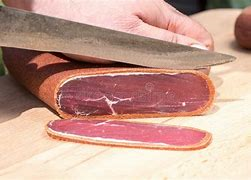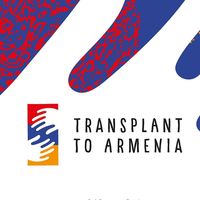 Le pasterma est un nom turc, derivé du verbe basmak signifiant « presser, appuyer ». Le mot est employé avec des variantes mineures dans les diverses langues de la région : pastërma en albanais ; باسطرمة, basturma en arabe ; բաստուրմա (pasterma), en arménien aboukht ; bastırma en azéri ; pastrma en turc, bosnien, croate, macédonien et serbe ; pasturma en bulgare ; παστουρμάς, pastourmás ou παστρουμάς pastroumás en grec et pastramă en roumain.
Le pasterma est un nom turc, derivé du verbe basmak signifiant « presser, appuyer ». Le mot est employé avec des variantes mineures dans les diverses langues de la région : pastërma en albanais ; باسطرمة, basturma en arabe ; բաստուրմա (pasterma), en arménien aboukht ; bastırma en azéri ; pastrma en turc, bosnien, croate, macédonien et serbe ; pasturma en bulgare ; παστουρμάς, pastourmás ou παστρουμάς pastroumás en grec et pastramă en roumain.
L'usage de la viande séchée de bœuf a été courante dans cette région pendant des siècles. Andrew Dalby mentionne son utilisation à Byzance. Le pastırma lui-même est habituellement considéré comme une spécialité arméno-turque (les charcuteries arméniennes sont réputées), bien qu'il soit produit et consommé dans une vaste région de l'Europe de l'Est et du Moyen-Orient qui correspond aux territoires appartenant à l'Empire ottoman.
Une légende dit que les cavaliers turcs de l'Asie centrale avaient l'habitude de conserver la viande en plaçant des galettes dans les poches latérales de leur selle, où elles étaient serrées par leurs jambes pendant qu'ils chevauchaient2.
Le bœuf, de préférence jeune, étant la viande la plus commune aujourd'hui, d'autres viandes sont également employées, y compris le chameau, l'agneau, la chèvre et le buffle.
Le pasterma est préparé en salant le morceau de viande tout en le pressant afin d'éliminer le maximum d'eau et de sang. La viande une fois sèche est prête pour être recouverte d'une pâte à base principalement d'ail, de cumin, de fenugrec appelé çemen en turc, de paprika, de piment d'Alep, le tout broyé. Une fois la viande enrobée de cette pâte de couleur rouge bordeaux, elle est laissée à l'air libre (cette préparation se fait plutôt en hiver).
Il peut être servi en mezzé, en tranches minces, habituellement crues, mais peut parfois être légèrement grillé, ou être ajouté aux différents plats, le plus célèbre étant un plat de haricots. Il est souvent accompagné d'un verre de rakı.
En Turquie, la version épicée, souvent appelée le Kayseri pastırması ou pasterma de Kayseri, est la plus commune. Le rumeli pastırması ou pasterma de Roumélie (les pays chrétiens de l'Empire ottoman situés à l'Ouest, donc essentiellement les pays balkaniques) est moins connu. Le pasterma balkanique est simplement salé.
|
HISTORY OF BASTURMA Armenian: ԱՊՈՒԽՏ (Aboukht)
Also called Bastirma or Pastirma, is an air-dried cured beef which has been strongly seasoned and is popularly consumed in the former Ottoman countries.The Bastirma is derived from Turkish word bastırma et . Bastirma et is non-finite verb of the word bastırmak , which means “to depress or restrain”. Various types of Bastirma recipes are enjoyed throughout the Eastern Europe. The Bastirma is famous throughout the region with names such as pastërma in Albania, basterma in Arabia, basturma in Armenia, basdırma in Azerbaijan, pastrma in Bosnia, Croatia, Macedonia and Serbia, pastărma in Bulgaria, pastourmás or pastroumás in Greece, and pastramă in Romania. Many people confuse Bastirma with pastrami which is a different type of meat preparation which has Yiddish origins. It is variously known as pastirma to (pastrómeh) in Yiddish. History of Pastirma:- The first recorded mention of Basturma dates back to 95-45 BC, and takes us to Armenia which was ruled by powerful emperor TIGRAN MEC. Armenian merchants travelled to far off lands such as China and India for trading. During the long travels these merchants packed homemade foods which will see them through bad times. At first only traditional vegetable dishes were packed for the journey and by the time these merchants came back they badly ached for the meats and other flavors of their land. It is believed that the technology of air-drying (the meat ) was developed during this time. The air-drying increased the shelf life of the beef, that’s how air-dried meat Bastirma came into existence. Its use is also mentioned in Byzantium by Andrew Dalby. It was originally called pastirma, derived from a Turkish word "bastirma", which means something is being pressed. It is also supposed that the primeval Turkish horseman, who belonged to Central Asia, kept dried and spiced meat sandwiched between horse and the saddle, to eat it whenever needed. Basturma Recipe Overview:- Basturma is made by salting meat, which is then washed with water and dried for about 10-15 days. Salt and blood is pressed out of the meat and it is covered with “çemen”, a cumin paste made by combining crushed cumin, garlic, hot paprika, and fenugreek. The meat is thoroughly air-dried. The variety of paprika being used, determines the spiciness of the dish. In the Ottoman Empire, the craftsmen from Central Anatolia specialized in the art of preparing and curing Batruma. Basturma Recipe in World Cuisine:- The Lebanese-Armenians launched Basturma in Syria as well as Lebanon in huge quantities where it is usually dished up as a mezze in fine slices. It is generally eaten raw, but it can sometimes be slightly grilled or eaten along with eggs for breakfast at times. It is often added to different dishes, mostly a bean dish. It is added to various pies too. In Egypt, Batrums ia eaten with fried eggs for breakfast. It may be used as a pizza topping or as a filling for several oven-made stuffed dough dishes, prepared from usual bread like dough, or a crumbly multi-layered puff pastry resembling dough. Palestinians eat the Basturma in thinly sliced form. It is fried in olive oil. It can either be served in the mezze table or it can be eaten for breakfast along with freshly made pita bread. Cypriots consume the Basturma whole and grilled. It is consumed during breakfast in Turkey. It is accompanied with eggs or eaten as a mezze with raki. There are a total of over 22 kinds of Baturma available in Turkey. The most popular one is the spiced version from Central Anatolia, which is called Kayseri pastırması. "Balkan pastırma" is less famous. It is just salted and dried. Georgian bastirma: This is the traditional Georgian marinated beef recipe where the diced beef is marinated in the spicy mixture of herbs and spices and served with spring onions, lemon wedges and cilantro. Beed ma'li bi-l-bastirma: This is a popular snack which is prepared with eggs and cooked bastirma. This snack is usually enjoyed with fruits. Beshbarmak: This authentic Kazak pastirma is enjoyed with boiled dough and fruits. Hot buttered hummus with bastirma: Lots of chardonnays go in the preparation of this dish. To impart earthy and peppery flavor to this bastirma you can add chianti and Rhone-style wine. Kuta: It is one of the most expensive bastirma recipes prepared across Europe. The meat is treated with various spice and herb mixes. Serving:- Basturma is normally prepared using the beef but goat, lamb, camel and water buffalo meats are also used. In Syria the dish is prepared by salting and drying the meat for 15 minutes. Then the meat is cured in cumin, paprika and other spicy mix. Pastirma is enjoyed as the main dish. Palestinians love to slice their pastirma’s and fry them in olive oil and they eat it with pita bread during breakfast. In Turkey Bastirma is enjoyed as the breakfast and eaten with eggs. Bastirma is also used as a topping for pizza. The culinary experts suggest that for best results the dish should be teamed with cognac, beer and brandy. Health and Nutrition information of Bastirma Basturma is considered to be good source of Phosphorus, Selenium, Niacin, and Protein. Bastirma recipes are generally preferred throughout Europe because they are good source of Vitamin B12, Zinc and Proteins. Some nutrition experts suggest that complimenting bastirma with other foods that are rich in amino acid will make it a complete protein source. But experts warn that bastirma is high in cholesterol and sodium which may induce adverse health effects.Basturma contains 120 calories per serving (10 fine slices). Trivia:- According to a legend Turkish horsemen of Central Asia used to take this meat with them and preserve the basturma meats in the pockets of their horse saddle, where they were pressed by the horsemen as they rode. Some food experts believe that Armenian pastirma and pastrami are distant cousins.
|








